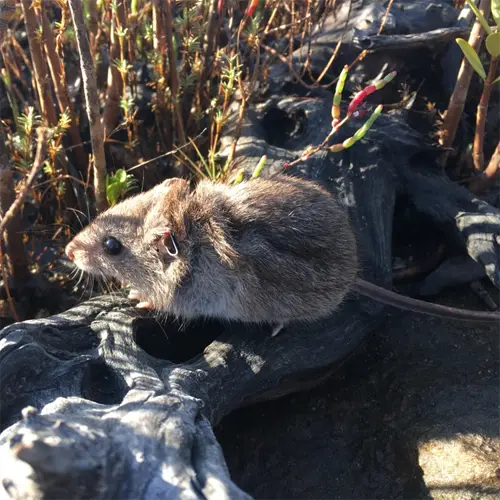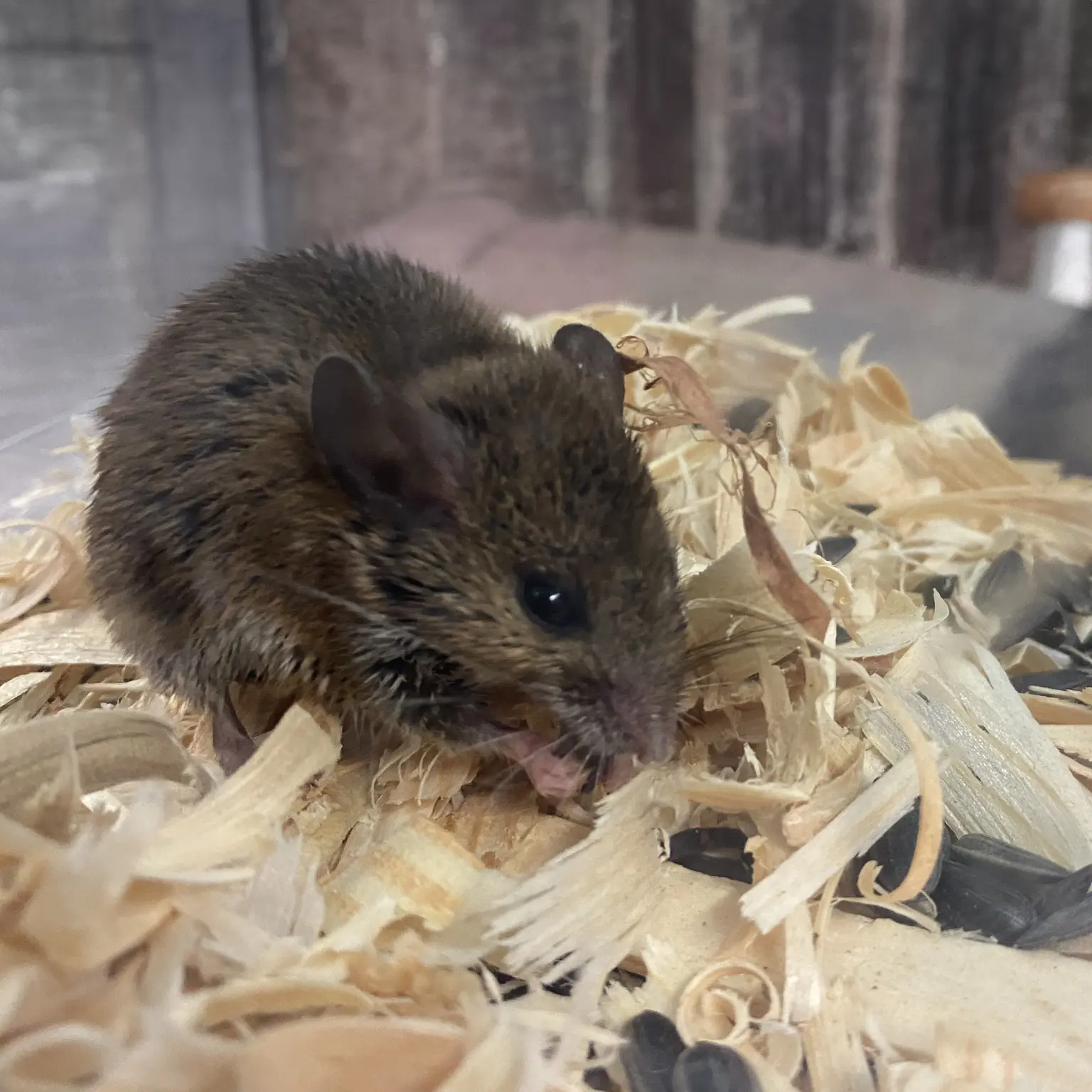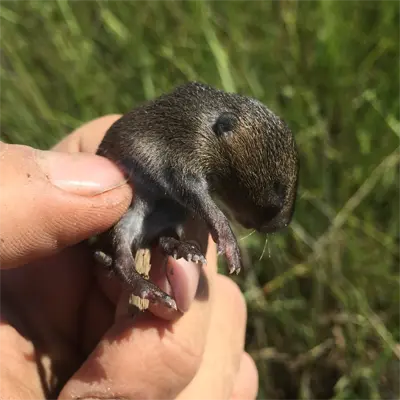Marsh Rice Rat
- Scientific Name
- Oryzomys palustris
- Also Known As
- Florida Marsh Mouse, Rice Meadow-mouse
- Range
- All of Florida
- Diet
- Crabs, Snails, Cordgrass
- Life Expectancy
- 1 Year
Quick Links
Round-tailed Muskrat (Florida Water Rat) in Central Florida
The marsh rice rat (Oryzomys palustris) is a semi-aquatic rodent species found throughout wetlands in central Florida.
Often confused with roof rats and Norway rats, rice rats can be identified by their smaller size, brownish-gray fur, white underside, and partially webbed hindfeet. This guide covers rice rat identification, biology, health risks, signs of infestation, and prevention and control in central Florida homes and properties.
Appearance and Identification
Rice rats can be distinguished from Rattus rats and house mice by the following physical characteristics
Rice rats are smaller and lighter in color compared to Rattus rats. They have smaller ears, shorter tails, and partially webbed hind feet unlike house mice. Careful inspection of tracks, tail scales, and droppings aids identification.
Maturation Rate
Young marsh rice rats grow quickly after birth. They open their eyes by 2 weeks old. By 3-4 weeks old, juveniles are weaned from maternal care and leave the nest. Rice rats reach adult size by 2 months of age. Their rapid maturation allows populations to rebound quickly after control efforts.
Habits and Behavior
Marsh Rice rats are active year-round in central Florida, often during the day and around dusk. They prefer wet, marshy areas and constructed burrows in grassy fields. Marsh Rice rats are good swimmers and climbers but stay mostly on the ground.
Outdoors, rice rats build spherical nests of grasses inside burrows or natural cavities. Indoors, they nest in dark, humid areas like attics and wall voids. Rice rats occasionally invade homes but prefer to remain near water sources. They are not very social and mostly solitary.
Reproduction and Lifespan
Marsh Rice Rats can breed year-round in central Florida. Females produce 2-4 litters annually with 2-7 young per litter. The gestation period is 27-30 days. Rice rats become reproductively mature by 60 days old. Their average lifespan is about 1 year in the wild.
Ideal Habitat and Range
Central Florida’s warm, subtropical climate with over 50 inches of annual rainfall provides ideal marsh habitat. Rivers, lakes, streams, wetlands, and flooded fields offer favorable semi-aquatic conditions year-round for rice rats to flourish.
Average temperatures ranging from the 60s to 80s F allow dense, grassy vegetation to grow along waterways and swamps where rice rats build burrows. Rural wetlands surrounding urban centers host large populations that occasionally disperse to nearby homes.
Access to water, food sources, and nesting sites allows marsh rice rats to thrive and reproduce rapidly in central Florida’s wetlands. Their periodic migrations into developed areas necessitates control measures to prevent destructive infestations.
Diet and Feeding

As omnivores, rice rats consume a diverse mixture of plant and animal material. Their diet varies based on seasonal availability but commonly includes
Aquatic Plants: Rice rats feed on emergent vegetation along waterways such as cattails (Typha spp.), water lilies (Nymphaeaceae), and the invasive hydrilla (Hydrilla verticillata). They consume the leaves, shoots, stems, and roots of these plants.
Terrestrial Plants: On land, rice rats eat grasses, sedges, millet, rushes, berries, seeds, fungi, tree bark, and roots. This provides carbohydrates, protein, and nutrients.
Invertebrates: Rice rats hunt insects, crustaceans, gastropods, and annelids as protein sources. They prey on grasshoppers, caterpillars, beetles, crayfish, crabs, and shrimp near water. Snails, worms, and insect larvae are also eaten.
Vertebrates: Small vertebrates supplement the rice rat diet. Rice rats consume fish, frog eggs, and the eggs and nestlings of birds. This provides additional protein.
Foraging: Rice rats forage for food both on land and in water. They swim and dive to collect floating mats of vegetation, allowing them to feed on aquatic invertebrates sheltered below. Rice rats generally consume 10-15% of their body weight in food daily. If their diet consists of moist vegetation and prey, rice rats do not need to drink much additional water.
Rice rats forage for food on land and in water. They can gather floating mats of vegetation to feed on aquatic invertebrates. Rice rats consume approximately 10-15% of body weight daily and can survive on plant matter alone. They do not need to drink much water if their diet is moist enough.

Common Health Risks
Rice rats can directly or indirectly transmit several concerning zoonotic diseases:
Hantavirus – Deer mice are the primary carriers, but rice rats can also become infected. Transmission occurs through inhalation of aerosolized urine, droppings, or nesting material. Hantavirus causes respiratory illness and potentially fatal pulmonary edema in humans.
Leptospirosis – Caused by Leptospira bacteria shed in rice rat urine. Transmission occurs through contact with contaminated soil or water. Leptospirosis causes fever, chills, vomiting, and muscle pain in humans if untreated.
Salmonellosis – Rice rats carry Salmonella in their gastrointestinal tract and spread it through their feces. Humans can become infected by ingesting food or water contaminated by rice rat waste. Salmonellosis causes diarrhea, vomiting, and abdominal cramps.
Rat-bite fever – Rare bacterial infection transmitted by rice rat bites or scratches breaking the skin. Causes fever, rash, muscle soreness in humans.
Rice rats can also indirectly cause allergic reactions and asthma symptoms in sensitive individuals. Nesting debris, urine, droppings, and dead skin cells can trigger immune responses. Excluding rice rats from indoor environments is essential to reduce health risks.
Preventing Rice Rat Infestations
The primary control method is exclusion by sealing possible entries into homes and structures
Trapping is useful for removing indoor populations. Outdoor populations can be reduced through habitat modification to get rid of dense vegetation along building perimeters. Rodenticides are also effective when applied carefully according to label directions.
Marsh Rice Rats in Central Florida – Conclusion
Rice rats are destructive, disease-carrying pests attracted to central Florida’s abundant wetland habitats. Their periodic dispersal indoors through small gaps necessitates vigilant exclusion and population control measures.
Identifying signs of infestation such as tracks, droppings, and nests allows early intervention before major damage occurs. By sealing structures, removing food sources, and establishing proper monitoring, rice rat invasions can be prevented through integrated pest management.







